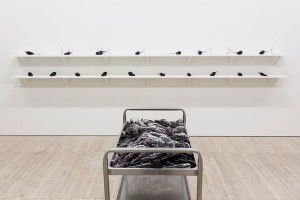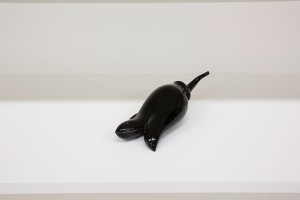Weak in Colour but Strong in Blood: Biennale of Sydney 2014

Blown glass and found components
Dimensions Variable
0.00

Blown glass and found components
Dimensions Variable
0.00

Blown glass and found components
Dimensions Variable
0.00

Blown glass and found components
Dimensions Variable
0.00

Blown glass and found components
Dimensions Variable
0.00

Blown glass and found components
Dimensions Variable
0.00

Blown glass and found components
Dimensions Variable
0.00

Blown glass and found components
Dimensions Variable
0.00

Blown glass and found components
Dimensions Variable
0.00

Blown glass and found components
Dimensions Variable
0.00
Yhonnie Scarce
21 Mar - 19 Jun 2014
WEAK IN COLOUR BUT STRONG IN BLOOD
Aesthetically beautiful, politically motivated and personally driven, Yhonnie Scarce’s delicately crafted glass work explores the continuing effects of colonisation on Australia’s First People. With its laboratory setting, her new work presented at the Art Gallery of NSW, Weak In Colour But Strong In Blood (2013–14), references the medico-scientific eugenic practices of the early 1900s, particularly those performed by the Australian anthropologist and ethnologist Norman Tindale, including on Scarce’s own family members.
Symbolic of Aboriginal people, different fruit skins are squashed into beakers, and the younger, lighter-coloured ones are segregated and separated into other trays ready to be sent to nice new white homes. Then there are the broken black bush plums, disfigured and discarded. Scarce reminds us of the harrowing ordeals that occurred in rooms like these all those years ago. This type of inhumane research resulted in dangerous forms of stereotyping that continue to shape attitudes around Aboriginality.
Glass is a lustrous medium. It can be simultaneously fragile and strong. At times it is transparent, like a window, or reflective, like a mirror. Glass can be a lens and a magnifier. Scarce uses these qualities like a paintbrush; utilising glass’s inherent features to extend the medium beyond its craft confines. Scarce’s fruits are full of beauty, heartbreak and despair; they are a multilayered motif. Not only does their symbolic nature reference the Commonwealth Government’s Flora and Fauna Act, amended in 1967, but they also evoke a striking connection to the food-gathering practices of women in the Central Desert region, where the fruits flourish and grow.
Burial Ground (2011) is a work that Scarce has revisited several times throughout her career and which gives voice to a number of Indigenous issues. Acknowledging the genocide that occurred throughout the years of first contact, the long yams in this work represent corpses and symbolise death; not only the death of the individual, but also that of spirit, identity, culture and tradition. Through the repetition of the little black objects, Scarce conjures the relentless impact of colonisation.
Scarce’s heritage stems from the Nukunu people, whose land stretches from Port Pirie to Port Lincoln along the coastal region of South Australia; and the Kokatha Mula, who called the expanse of the pristine Mallee country from outback Ceduna to the Eyre Peninsula home. Her heritage is deeply imbued in her work, and she often creates a dialogue about her own family and their personal histories. Courageously, she expresses the social and political patterns found in historical and contemporary Australian culture, while pointing out the breakdown of Indigenous social structures. By presenting such strong messages of survival and culture, Scarce boldly exposes histories lost, forgotten, hidden or ignored.
